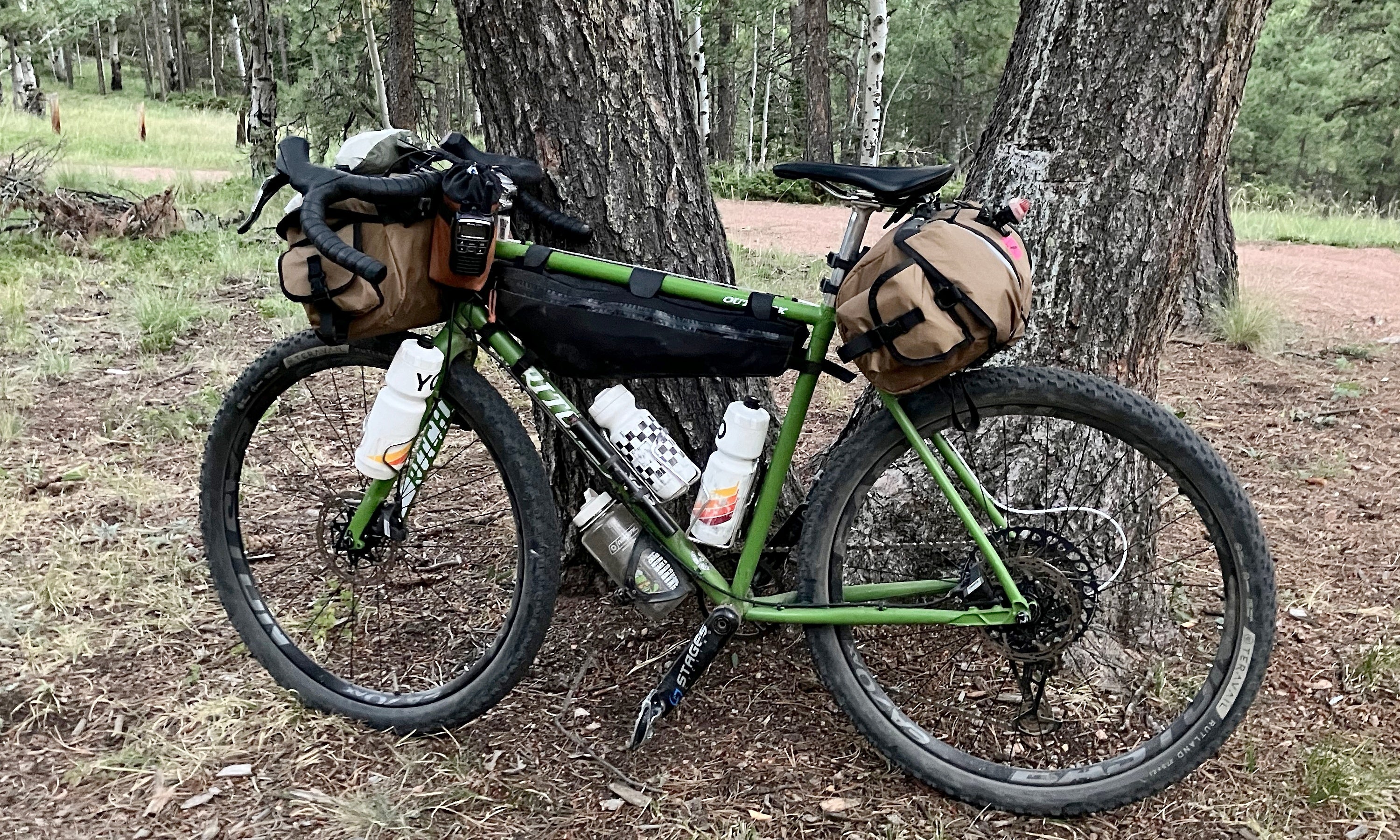One ring to rule them all … or it takes two to tango? Nearly every bike company has jumped on the gravel bandwagon in the last few years. That results in far more choices when it comes time for you to build up your dream gravel bike. So how do you decide between a single-chainring and a double-chainring drivetrain?
Let’s weigh the pros and cons of the two setups. We’ll start by considering the two basic quantitative differences between single- and double-ring setups, stuff we can easily measure. Then, we’ll outline the more qualitative differences that set the two apart.

Weight
Gravel is a new bike category, different from road, mountain bike, and even cyclocross, but they’re still subject to the same scrutiny in terms of weight. Lighter bikes are almost always more desirable.
As you’d expect, a single-chainring drivetrain with fewer components is lighter than a double-ring bike, all things equal. But how much lighter?
In the case of SRAM’s Force AXS drivetrain, a front derailleur weighs about 200 grams, and a double-chainring crank is about 46 grams heavier than a single-ring. Shimano’s gravel-specific GRX group also offers both options. Its double-ring crankset is 55-66 grams lighter, depending on chainring size, and it’s cable-actuated front derailleur weighs 96 grams. An electronic GRX Di2 front derailleur weighs 135 grams. So, worst-case scenario, a double-chainring setup adds 246 grams.
“If you’re looking at ultimate weight, then going one-by makes a lot of sense,” says Nick Legan, author of “Gravel Cycling” and Shimano’s road brand manager.
Do you care about 200-250 grams of additional weight? That’s your call. If you’re trying to wrap your head around what that weight means in the real world, a full, 21-ounce water bottle is about 650 grams.
Gearing — range and gaps
Kansas has a reputation for being “flat as a pancake.” Anyone who’s ever ridden the famous Dirty Kanza gravel race will tell you that is bogus. Nearly anywhere you find gravel, you find hills. That’s because beautiful, quiet dirt roads don’t usually take the direct, flat route from point A to point B. When it comes to bike gearing, you’ll have to consider the length and steepness of your hills as well as how fast you plan to ride up (and down) them.
The first gearing consideration is range: How much difference do you have between your hardest gear and your easiest gear? In terms of modern drivetrains, double-chainrings usually win this debate.
Within SRAM’s Force AXS drivetrain family, the easiest possible single chainring is 36 teeth and the hardest is 48 teeth. Combined with a 10-36-tooth cassette, one ring doesn’t offer the range of a 46/33- or a 48/35-tooth Force AXS crankset on the same cassette. You run into the same limitation with Shimano GRX, which only offers a 40- or 42-tooth single ring. That can’t match the range of a 48/31-tooth double crankset on a standard 11-32-tooth cluster.
“Sometimes, you’ll see a really strong rider with a one-by because they don’t need that gear range. They are climbing hills much faster, so they have a narrower range of speeds from minimum to maximum,” says Legan. “Don’t always look to elite riders to choose your equipment. Some of the gearing I’ve seen on their bikes at gravel races is truly impressive.”

Fortunately, you can get a single-ring gear range close to that of a double-chainring setup using a wide range cassette. With SRAM products, you can opt for a Force 1 mechanical drivetrain that runs a 10-42-tooth cassette. For even more range, you can also run an Eagle AXS mountain bike rear derailleur with a 10-50t cassette with Force AXS shifters — colloquially known as a “mullet” drivetrain. Shimano also has an 11-42-tooth XT cassette that would work with a long-cage GRX derailleur.
Those wide-range cassettes all have a drawback, however. They have larger gaps between gears. As you shift through the cassette, you won’t always be able to maintain the ideal cadence and effort level, depending on the terrain.
“Oftentimes, one-by has a narrower total range, and sometimes it has larger jumps between gears,” Legan says. “On gravel, I’d admit I don’t notice the jumps as much as I thought I would, but a lot of roadies talk about wanting the tighter gearing.”
As you might expect, a SRAM AXS mullet drivetrain will be heavier in the cassette and rear derailleur — 352 and 354 grams, respectively — compared Force AXS, which weighs in at 309 grams for a 10-36T cassette and 326 grams for the rear derailleur. However, if you compare the mullet to a double-ring setup on Force AXS, that 71-gram difference is offset by the weight of the front derailleur alone.
Simplicity vs. complexity
Even a double-chainring devotee has to admit that there is a simple elegance to a single-chainring bike. SRAM has led the uprising against the front derailleur, especially on mountain bikes, and that technology has translated into cyclocross and gravel bikes.
Without a front derailleur, shifting logic is simpler. That’s good for new riders who don’t have the experience to know when you should (or shouldn’t) shift your front derailleur. Plus, without a front derailleur, you have one less wear item, one less adjustment to make when tuning a bike, and one less thing to go wrong when you’re out in the boonies.
“One-by is good for beginners,” Legan adds. “It’s easier because you don’t have to think about shifting too much. Plus there is less to maintain, it's lighter, and aesthetically pleasing — one-by has a lot going for it.”
In terms of maintenance, you might also argue that chainring wear is distributed between two rings on a double drivetrain, making that less of a concern than it would be on a single ring.

Rider background
As mentioned in the last section, SRAM has made front derailleurs virtually extinct on modern mountain bikes. Shimano has followed suit. On the road, however, you still see plenty of bikes with double-chainring drivetrains.
The great thing about gravel riding is it is a meeting place for riders who come from mountain bike backgrounds and those who come from the road. As such, drivetrain choice can sometimes reflect an individual’s prior experience. A single-ring gravel bike will feel more familiar to a mountain biker, for instance.
“A lot of our decisions with gravel are informed by our origins. If you’re coming from mountain biking, you have a certain experience and from road, it’s another experience,” Legan adds. “I’ve ridden mountain bikes for a long time, but I am certainly a road cyclist. The two-by system is home to me. That ‘s where I feel comfortable.”
Chain security
When we talk about current groupsets like SRAM AXS or Shimano GRX, we take for granted the fact that they all have clutch rear derailleurs. The clutch mechanism holds the derailleur cage tight, preventing chain-slap on bumpy roads. This also helps reduce the risk of dropping your chain.
It’s worth noting that previous drivetrain generations don’t always have clutch derailleurs. You might encounter some pre-owned gravel bikes with Shimano 105, Ultegra, or Dura-Ace, or others with SRAM Rival, Force, or Red.
With one of those drivetrains, you won’t have as much chain security. In that case, your best option might be SRAM Force 1, a single-chainring group that has been around for several years and always has employed a clutch rear derailleur. It also has a narrow/wide chainring, which is designed to hold a chain on. Double cranksets employ chainrings designed to facilitate shifting with pins and ramps, and those aren’t conducive to chain security.
If you ride mellow dirt roads, this may not be a problem. If you’re adventurous and often end up on chunky Forest Service roads or even some singletrack, a clutch derailleur could be … well ... clutch.
Spencer’s take
Up until Shimano and SRAM started offering clutch rear derailleurs for double-ring drivetrains, I was a devoted single-chainring rider. The roads and trails I ride are rough enough that I don’t want to worry about chain security. I also ride mountain bikes a lot, so it’s normal to have a wide-range cassette. Plus, the simple aesthetics of a single-ring look good.
However, I also like to race some gravel events, and I do notice the gearing limitation if I’m riding in a group. Sometimes I feel like I just can’t get comfortable with my pedaling cadence. Other times my gear range isn’t wide enough.
So, for my next gravel bike, I’ll choose SRAM Force AXS. It seems like the perfect combination of features for me.
Legan has a similar take, and I trust the guy. After all, he literally wrote the book on gravel:
“I’ve done Dirty Kanza several times — on singlespeed, two-by, and one-by,” he says. “Personally, I still resort to a two-by. Part of it is how I use my bike. I use it as my road bike, as well as my gravel bike with a change of wheels. Because of that, I’m going fairly quickly, especially in Colorado on long descents, so I don’t want to give up my top-end gear. I want maximum versatility, even if I have some overlapping gears.”

























